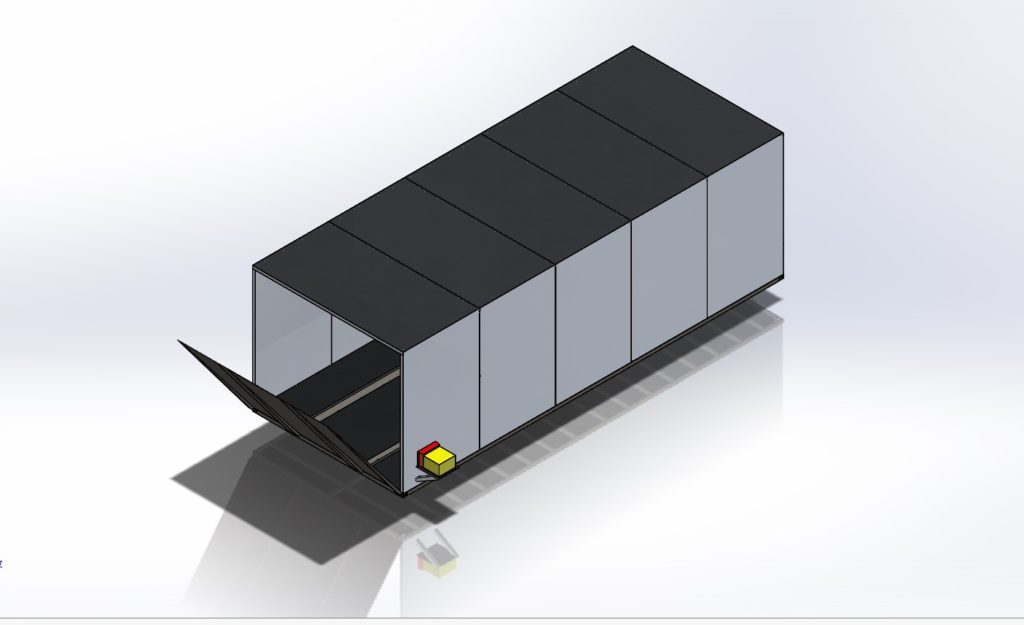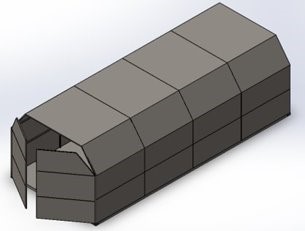At the beginning of the school year, Chris Raatz pitched a Capstone project working with Sierra Nevada Corporation (SNC). The project was to work with the Ground Operations (Ground Ops) team out of Louisville Colorado, the team he had been a part of for his internship that summer. The Ground Operations team wanted an ERAU Capstone team to fully design and validate a container to be used to transport the Uncrewed Dream Chaser (UDC). The team was then selected and formed, and a team lead was chosen. Maggie Mueller became the team lead, with team members Chris Raatz, Madison Sartain and James Robinson. From there the team had to brainstorm ideas for what the container would look like. Weekly phone calls with the Ground Ops team helped to define the project and hone in on what the container needed to accomplish. The first iteration of the container, called the UDC Transport Cover (UTC), was a simple box with a draw-bridge door.

First Iteration of the UTC 
Second Iteration of the UTC 
Newest Iteration of the UTC
First iteration of the UTC
This was the design that the team presented at the Preliminary Design Review in December. This project is under a Non-Disclosure Agreement with the company, so the presentation was only open to ERAU faculty. Shortly after this presentation, in late January 2019, several members of the Ground Ops team decided to come visit us and work with us for a few days on the project. This was very beneficial to the project as well as to the team members to be able to work with professional engineers and get feedback. The design was going well after this, however, the week before spring break, the Ground Ops team decided that they needed to change the concept of operations for how the UTC would be loaded. They told the team that instead of using a door, they would like to crane the payload in, which meant that the top five sides needed to be removable. At this point in time the UTC had changed slightly to have barn doors and chamfered edges.
Second iteration of the UTC
This was a difficult change for the team, however we faced it head-on, with the knowledge that big changes would be passed down to us in our engineering careers and we would have to find a way to figure it out. At this point, James and Chris were able to take a trip to visit with another company that is designing a piece of equipment that has to interface with the UTC. This meeting with Fulcrum Engineering in Fort Worth Texas was very informative and helpful in order to get the redesign on the proper track. After several weeks of working the redesign, the newest model has chamfered edges and a separate floor plate.
Newest iteration of the UTC
The team also designed, constructed and tested a four foot square container with a unit cell of the UTC wall in order to figure out what the heat transfer through the wall will be. The UTC has to be able to control its environment due to the fact that it is transporting spaceflight hardware. Being able to get our hands dirty with welding, cutting, insulation and assembly was great!
The team also had to opportunity at the beginning of April to travel to the SNC office in Colorado to spend two days working with the Ground Ops team and getting feedback on the redesign. The Ground Ops team was very helpful in ensuring that we had all different types of engineers from structural to heat transfer to electrical to meet with to ensure we could get all of our questions answered. The office is very nice and the people are great to work with. We also got to see the test article that was dropped at Edwards Air Force Base and successfully landed on the runway (https://www.youtube.com/watch?v=aDEKSPOLXAc).

For the remainder of the semester the team will be working to complete the design and finish up the details of the container. We are excited to send our design to SNC for final review and for it to be built and used to aid in the mission of the Dream Chaser!













